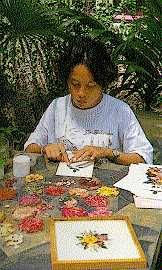

|
"All kinds of plants and trees have their intrinsic values, from humble flowers of grass that grows on the ground to eucalyptuses that reach out to the sky. Even weeds like gramineae, or hyacinth, or wild acadia are useful. If we use our brains, we can always find a way in which these plants can be utilized".
(From an article written by Associate Professor M.L. Charuphant Thongtham).
Royal Projects are projects to which His Majesty the King has donated his personal money for their research work. The aim is to encourage cash crop cultivation among the hilltribes of the north in replacement of opium growing, which has always caused a great deal of problems for the government.
All of these projects have been successful from the start. One of the projects which has been carried out continuoudly until the present, and whose products have been well recorganized for their quality, is the dried flowers project.
|




